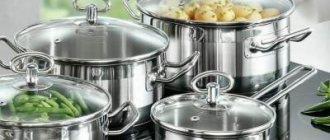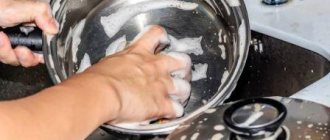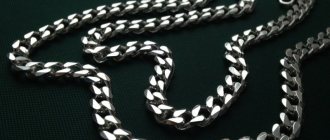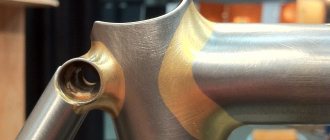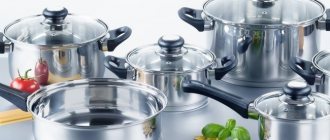The kitchens of many of our customers are equipped with stainless steel sinks, the popularity of which is due not only to affordability. Steel sinks harmonize with many types of materials and, with proper care, retain their impeccable appearance for a long time. They are also aesthetically pleasing, hygienic, and, most importantly, practical.
From the article you will learn why durable stainless steel sinks need gentle and careful care. We'll tell you how to clean stains from stainless steel sinks and what products can be used to remove plaque and rust.
Image by fiatlux (source – flickr.com)
Characteristics of raw materials
Stainless steel is an alloy based on iron with alloying additives (chrome, nickel, steel). Each additive enhances the positive and reduces the negative parameters of the raw material. The resulting metal is much stronger than conventional analogues.
Advantages of the material Source ua.all.biz
Corrosion resistance is the main advantage of modified iron. When exposed to oxygen, chromium forms a thin layer of insoluble oxide on the surface. The film makes the alloy inert towards aggressive substances. The barely noticeable protection prevents the metal from entering into chemical reactions with the environment.
Nickel in the composition gives the alloy ductility, viscosity at low degrees and increases heat resistance. The material has a wide operating temperature range. The additive reduces the spread of spot and contact rust. Durable modified steel does not collapse when:
- stretching;
- welding;
- bending;
- rental
The need for regular cleaning of stainless steel
Most often, stainless steel can be found in the kitchen: utensils are made from it
. Products made from stainless steel are among the most durable in the world, thanks to this they last a long time and are resistant to external irritants.
The composition includes chromium, therefore, it contributes to the formation of an oxide film on the surface, which protects the product from corrosion (rust). Moisture and other unfavorable factors have a negative impact, which causes plaque to form. If you do not provide regular and high-quality care for your products, they will also be susceptible to corrosion, scratches and damage.
During care procedures, it is extremely important not to damage the integrity of the chrome coating, therefore it is prohibited to use metal sponges or soft sponges with hard abrasive particles, this will damage the protective layer.
Remedies for carbon deposits
Dark spots on stainless steel are carbon deposits (soot), which occurs after drops of fat enter. If you don't clean the dirt right away, it will harden over time. The hard “coating” darkens, so it is difficult to remove using conventional methods.
Before you clean stainless steel from dark stains, it is important to choose the right composition. On the outside, baking soda works best to remove carbon deposits. The raw material has mild abrasive properties, so it must be used carefully. Hot water is poured into the container, and the walls are generously rubbed with a paste of powder and liquid soap. Periodically move the sponge over the surface, removing soot. After the moisture has cooled, the remaining mass is thoroughly washed off and rinsed with vinegar.
How to clean a kettle from stains Source ratatum.com
Food crumbs on cutlery and carbon deposits on the inner walls often grow into a hard crust. A solution of:
- soda ash – 2 tsp;
- liquid soap – 100 ml;
- PVA glue – 100 ml.
The ingredients are diluted in 4 liters of water and poured into the problem container. The moisture should completely cover the soot. The dishes with soot are placed on low heat and boiled for 20 minutes. After the liquid has cooled, dark stains can be easily removed with a sponge.
Special softening pastes will help remove remnants of burnt food (porridge, jam) or traces of escaped milk in stainless steel dishes. For example, activated carbon powder works well. The crushed tablets are poured onto the bottom and covered with water on top. After a quarter of an hour, the soot is removed with a sponge. Drinking coffee grounds have similar properties.
How to remove carbon deposits Source biolshop.com.ua
An acidic environment will help remove greasy deposits from stainless steel. Both table vinegar and lemon juice solution will do. Water is poured into the problematic dishes and a cleaning ingredient is added. If liquid, then 100 ml. Take 20 g of crystals from a bag. Boil the moisture, leave it to cool for 1 hour, then heat it up to 100 C. In advanced cases, you can keep it all night. After time, dark spots are removed with a sponge.
Stainless steel sinks and hoods are washed with an acidic solution. Small stains can be wiped off with a slice of lemon, large stains can only be wiped off with a generous application. For convenience, spread the composition over the surface with a soft sponge. A paste mixed in equal quantities of soda and dry mustard will help enhance the effect. After the fizzing is completed, the ingredients are washed off.
Stainless steel device Source gibbsbrand.info
Recommendations for caring for bronze and stainless steel items
When cleaning bronze and stainless steel, it is necessary to provide for the possibility of preserving the renewed state. The fact is that after removing the plaque with reagents, an invisible oxidation reaction begins to occur in the upper layer, destroying the metal.
After cleaning, bronze products require protective surface treatment. For these purposes, compositions of natural origin based on natural wax are used.
As for stainless steel, to preserve its original appearance, experts do not recommend washing things in the dishwasher. For daily cleaning of food debris, it is better to use a regular sponge in combination with a suitable detergent. Do not use cleaning abrasives, sponges or metal scourers. Their use leads to the formation of scratches and loss of the characteristic shine of the dishes.
Useful tips
In addition to the techniques and methods discussed above, the following recommendations may also be useful:
- Tarnishing of bronze can be easily removed by applying pre-cooked peas and brought to a paste state to the surface. The liquid mixture must dry completely, after which the product is washed in boiling water and wiped with a damp cloth.
- You can restore the natural appearance of bronze objects with toothpaste applied to flannel or suede. After processing, rinse the item with water and dry.
- Ammonia and mustard powder can be used to clean bronze from plaque.
- Coffee grounds are used to restore the characteristic shine of stainless steel.
In conclusion, we note that the procedure for using these funds is similar to the methods discussed earlier
Please note that the listed methods and approaches for cleaning stainless steel and bronze are based on effective time-tested traditions
Loading …
Responsibility requires work to give the original appearance to expensive bronze art products. The technology requires restoring their characteristic shade. Only in this case will a bronze figurine or other object become a spectacular addition to the interior or shine at exhibitions.
Anti-scale agents
Scale is a limescale deposit that appears when using hard water. The calcium carbonate in the liquid reacts with the metal, eventually forming a dense whitish layer. When boiling, mineral ingredients in the form of flakes settle to the bottom of the pan. A thin, sloppy coating appears on chrome surfaces of radiators, household appliances and furniture.
An acidic solution (lemon, vinegar) will help get rid of limescale deposits inside kitchen utensils. The liquid in the problem container is brought to 100 C, then boiled over low heat and left to cool for an hour. After time, the moisture is removed and the dishes are rinsed.
Removing plaque from the sink Source zen.yandex.com
An acidic environment will help remove a thin layer of limescale on a chrome tap, heated towel rail or furniture elements. The warm solution is distributed using a spray bottle or applied with a sponge. The procedure is repeated every 15 minutes. After an hour, wipe the surfaces with a damp cloth.
Heavy limescale deposits in a kettle or pan can be removed with Coca-Cola. Add 50% of the carbonated drink to the kitchen utensils and slowly bring to a boil. The scale is scrubbed off after 30 minutes with a regular sponge.
Video
To familiarize yourself with the nuances of cleaning stainless steel items, watch the following videos:
Young mother, wife and part-time freelancer. Being a lawyer by training, I am accustomed to collecting and providing the most complete and reliable information. Constantly improves in the professional field and strives for personal growth and development.
Found a mistake? Select the text with the mouse and click:
Stretch ceilings made of PVC film can withstand from 70 to 120 liters of water per 1 m2 of their area (depending on the size of the ceiling, the degree of its tension and the quality of the film). So you don’t have to worry about leaks from neighbors above.
Fresh lemon is not only suitable for tea: clean dirt from the surface of an acrylic bath by rubbing with half a cut citrus, or quickly wash the microwave by placing a container of water and lemon slices in it for 8-10 minutes at maximum power. The softened dirt can simply be wiped off with a sponge.
The easiest way to remove scale and carbon deposits from the soleplate of the iron is with table salt. Pour a thick layer of salt onto the paper, heat the iron to maximum and run the iron over the salt bed several times, applying light pressure.
The dishwasher cleans more than just plates and cups. You can load it with plastic toys, glass lamp shades and even dirty vegetables, such as potatoes, but only without using detergents.
There are special traps to combat moths. The sticky layer with which they are covered contains female pheromones that attract males. By sticking to the trap, they are eliminated from the reproduction process, which leads to a decrease in the moth population.
Before removing various stains from clothing, you need to find out how safe the selected solvent is for the fabric itself. It is applied in a small amount to an inconspicuous area of the item from the inside out for 5-10 minutes. If the material retains its structure and color, you can move on to stains.
Threads made of gold and silver, which were used to embroider clothes in the old days, are called gimp. To obtain them, the metal wire was pulled for a long time with pliers to the required fineness. This is where the expression “to drag out the rigmarole” came from - “to do long, monotonous work” or “to delay the completion of a task.”
If your favorite things show the first signs of gestation in the form of untidy pellets, you can get rid of them using a special machine - a shaver. It quickly and effectively shaves off clumps of fabric fibers and returns things to their proper appearance.
The habit of using an automatic washing machine “sparingly” can lead to the appearance of an unpleasant odor in it. Washing at temperatures below 60℃ and short rinses allow fungi and bacteria from dirty clothes to remain on internal surfaces and actively multiply.
Source
Bring back decorativeness
Shine is a recognizable feature of stainless steel. Over time and after washing, dishes, household appliances and heating devices lose their former attractiveness. There are ways to help restore decorativeness.
Toothpaste and ammonia will help get rid of rainbow stains on stainless steel. Add a couple of drops of alcohol to the cleaning mixture, then apply it to the defects with a napkin. After a couple of minutes, rinse with clean moisture.
Bring back beauty to the alloy Source aredi.ru
To make kitchen utensils shine, use lemon juice. For a liter of cold water, 1 teaspoon of liquid is enough. Dip a sponge into the solution and rub generously over the surfaces inside and out. Cutlery can be soaked for a couple of minutes. Then the dishes are rinsed and wiped dry with a clean cotton towel.
Raw potatoes will help polish your stainless steel sink, hob and hood. The tuber is cut into halves. The wet side is rubbed over the problematic surface, then rubbed with a dry cloth.
Cleaning: what is special?
A stainless steel sink is very aesthetically pleasing and beautiful to look at, but is difficult to maintain. This is the most versatile and frequently used type of kitchen equipment. Easily fits into any interior. However, despite all the inherent advantages of a bowl-shaped device, there are also several disadvantages in using stainless steel sinks:
- small scratches, marks and stains on its surface are always noticeable;
- poor sound insulation;
- predisposition to oxidation;
- various negative reactions to cleaning products.
To keep your sink in good condition, you need to take care of it and do general cleaning at least once a week. This will not only give the kitchen an aesthetic appearance, but will also protect the whole family from various diseases.
Household chemicals
Ready-made industrial products are ideal for those who do not have time to boil or mix homemade solutions for a long time. Household chemicals act very quickly. During the procedures, it is important to adhere to the period specified in the instructions. Contact with stainless steel for too long will destroy the chromium oxide.
The Russian product “Sanita anti-grease” will do an excellent job of removing dark carbon stains on dishes, sanitary and household appliances. The chemical is produced in different forms. To clean the hob, hood and sink, use a spray liquid. Concentrated gel is ideal for dishes. On average, exposure should not exceed 20 minutes, after which it is washed off generously.
Household chemicals for alloy Source shop.nissa-biysk.net
“CIF” and “Shumanit” have similar characteristics and are marked “Anti-grease for stainless steel.” The alkaline preparation “Lyma Professional” does an excellent job of removing carbon deposits on metal surfaces. The only requirement for all chemistry is to work with gloves.
To combat limescale, “CILLIT BANG” has proven itself well. Simply spray the liquid and leave for 15 minutes. After a quarter of an hour, wipe off the remaining scale with a rag. Additionally, it eliminates bacteria, which is important for washing.
Concentrated products are used to remove congealed fat on the hob and hood. Aerosol “HD” is classified as a professional household chemical. The drug is evenly applied to dark spots, left for 5 minutes, then removed with a cloth. The treated part must be thoroughly rinsed with water.
Shine product Source deshevle-net.com.ua
To add shine to stainless steel household appliances, use Indesit for polishing and Kenolux Shine. The products have a similar operating principle. The liquid from the spray bottle is distributed over the problem surface, then wiped dry with a rag. Chemicals perfectly remove dirt, plaque and fingerprints on the capricious alloy.
Expert advice
- Regardless of the degree and types of contamination of the surface made of stainless steel, avoid using products containing caustic alkalis, chlorine, concentrated acids, and preparations with coarse abrasive particles;
- Only competent selection of a solution cannot guarantee the integrity of the protective layer of the slab - what you use for cleaning is also important: it is unacceptable to use brushes with hard bristles or metal sponges;
- If scratches cannot be avoided, cover the surface with a special polishing agent or treat it with vegetable oil, followed by rubbing with paper.
Putting a stove in order that is in a neglected state can take a lot of your time and effort.
Give the “queen” of the kitchen daily attention - at least for 10-20 minutes: try to clean it after each cooking, immediately remove burnt food, and the stove will always look neat and well-groomed.
How to properly care
In order not to look for how to clean stainless steel from dark stains, it is important to remember the rules of care. After each cooking, carefully remove any remaining food and fat from the dishes. During heat treatment, food should not burn to the bottom. Leaked traces are removed from both the utensils and the cooking surface of the stove.
The joints of the handles are the vulnerable part of the cookware. When washing with aggressive chemicals labeled “anti-grease,” you should not apply them to these areas. Contact with an unfavorable environment may cause corrosion stains.
Features of care Source takprosto.cc
